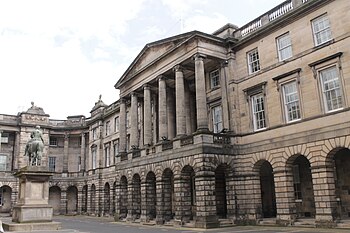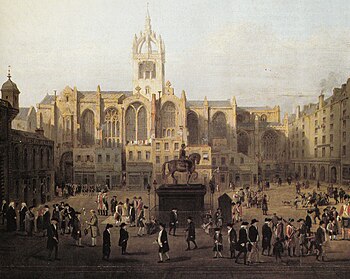Parliament Square, Edinburgh

Parliament Square,Edinburgh,Scotland, is located off the High Street, part of theRoyal Mile.[1]The square is not a formal square, but consists of two sections surroundingSt Giles Kirkon three sides: an L-shaped area to the east and south and another area on the west side of the church called West Parliament Square. TheEdinburgh Mercat Cross[2][3]is located on the east side of the square while an equestrian statue ofCharles II of Scotland[note 1]stands in front of the entrance to theSupreme Courts of ScotlandadjoiningParliament House,on the west side.[4]The Queensberry Memorial to the5th Duke of Buccleuch,stands in West Parliament Square.
The square also includes a statue ofJames Braidwood,erected in 2008, who founded what is asserted to be the world's first municipal fire service, in Edinburgh, after theGreat Fire of Edinburghin 1824.
History[edit]

The square came into existence in 1632 as a forecourt to the Parliament House on the old graveyard of St Giles Kirk. Parliament House not only housed the pre-unionParliament of Scotlandbut also the Court of Session (the supreme civil court in Scotland). This made the square a centre for the meeting of politicians and lawyers before they entered the building, from the time of its creation until the dissolution of the Scottish parliament with the Act of Union in 1707.[5]
Another building adjacent to the square was theOld Tolbooth,which was "used variously as a meeting place for the Town Council, a tax office, law court and prison, it was finally torn down in 1817".[6]It was from there in 1661 that those found guilty of high treason after theRestorationwere taken to be executed next to themercat cross.[7]
Henry Cockburnlamented the loss of the square's historical name, Parliament Close, a change he attributed to the silliness of fashion ( "foppery" ) when he wrote his memoir of life in Edinburgh in the 1820s.[8]
Notes[edit]
- ^The equestrian statue of Charles II dates from around 1685. It was the first lead statue in Edinburgh and one of the first in Great Britain (EWH staff 2012a).
References[edit]
Citations[edit]
- ^EWH staff 2012b,p. 4.
- ^EWH staff 2012.
- ^EWH staff 2012a.
- ^EWH staff 2012b,p. 3.
- ^EWH staff 2012b,p. 1.
- ^EWH staff 2012b,p. 2.
- ^Anderson 1851,pp. 1, 2 (PDF).
- ^Cockburn, H (1856),Memorials Of His Time,Edinburgh: Mercat Press reprint, p. 106
Sources[edit]
- Anderson, James (1851),"Mrs. James Guthrie, Mrs. James Durham, and Mrs. John Carstairs"(PDF),Ladies of the Covenant: Memoirs of Distinguished Scottish Female Characters
- EWH staff (2012),A sense of place,Edinburgh World Heritage, archived fromthe originalon 1 October 2011
- EWH staff (2012a),Parliament Square,Edinburgh World Heritage, archived fromthe originalon 2 October 2011
- EWH staff (2012b),Parliament Square(PDF),Edinburgh World Heritage, archived fromthe original(PDF)on 18 October 2015
